
 This review was made possible by Sharman MultiCOM Ltd, with thanks to Murli for the loan of the equipment.
This review was made possible by Sharman MultiCOM Ltd, with thanks to Murli for the loan of the equipment.
The TCB-771 is another fairly recent addition to the radio of CB radios made by TTi. It follows on from the popular TCB-770 that has been around for a number of years. TTi have taken some comments on board regarding the operations of the radio and got rid of the dual function control knobs that were often criticised for being difficult to operate especially under mobile conditions. Another improvement has been the ability to connect the radio directly to 12v and 24v supplies, thus making it ideal for use in trucks and other vehicles with a 24v system without the use of a voltage dropper making the possibility of frying the radio somewhat lower.
If packaging sells products then TTi should be onto a winner with this radio. The box contents are well presented with a nice glossy cardboard carton and really well packaged into a compact container. The instruction manual is well written in good quality English and contains plenty of pictures and diagrams to help explain the basics. This is actually a multi-language manual with a selection of the most popular languages including Russian. Also found in the box is a small mounting bracket, thumbscrews, power cord, microphone and mic mounting bracket and last but not least the power cable with quick release connector.
Lighting on the TCB-771 has been provided by bright blue LED’s just like previous models and the keys are also backlit for superb night time illumination. The display and controls can be dimmed via the menu driven system provided by a series of “power on” key presses as can many other options including bands, scanning etc but we’ll cover these a little bit later on in the review.
Looking at the front panel of the TCB-771 it becomes apparent that this radio is suitable for DIN mounting in a free slot inside most vehicles thanks to the front mounted microphone socket. With regard to dimensions the radio is ever so slightly smaller than its predecessor at 140mm (w) x 37mm (h) x 186mm (d). At this kind of size the radio should be suitable for mounting almost anywhere although for the main part of my tests I left it on the bench at home next to the power supply and this is where I made my first observation of the power lead – it’s really short and another thing that I’m not really in favour of is the hard-wired power lead, the radio has no power socket and the cable terminates into a grommet at the back of the radio. Whilst this might seem like a very small issue I’ve bought radios second-hand over the years that have this kind of direct connection and the previous owners have simply chopped of the power lead when they’ve changed vehicle (rather than using the proper 2 pin inline power joining connector) or used insulating table to join another length of cable to the radio! Surely it wouldn’t cost much extra at the factory to fit a power socket? If the worst happens with the current arrangement and the lead gets damaged it means opening your radio and soldering a new length of cable to the PCB which isn’t a job for everyone! It’s just a small point but one I feel is worth mentioning.
 At the back of the radio we have the usual range of connections to the essential SO239 connector, an external 3.5mm speaker jack socket and a slightly smaller 2.5mm S-Meter socket for those who prefer to connect up an analog style S-Meter and that’s about it in the way of external connectivity.
At the back of the radio we have the usual range of connections to the essential SO239 connector, an external 3.5mm speaker jack socket and a slightly smaller 2.5mm S-Meter socket for those who prefer to connect up an analog style S-Meter and that’s about it in the way of external connectivity.
As the TCB-771 is a multi standard pan European radio it comes as no surprise that it is capable of transmitting on all EU approved CB channels and modes. The radio includes the use of AM for those countries that allow this great mode of communication as well as the obligatory FM mode, love it or hate it! Band selection should be a one time process unless you are travelling across Europe into different territories but it is very easy to select the legal channels for your country by simply turning the radio off and then holding down AM/FM and Scan whilst turning the radio back on. Once you perform this operation the radio displays a two character band code to indicate the current setting such as “EC” or “PL” you can then use the channel selector to change the setting and then press the AM/FM button again to confirm your choice. This is a really easy way to select bands and comply with your country’s radio regulations. In the UK we have a choice of three band selections across 80 channels. Setting the radio to EC gives access to the 40 FM channels that are acceptable anywhere within Europe at 4W output but can also choose “UK” which gives is 40 channels of UK only 27/81 classic channels or if you want access to the whole 80 channels in one go then the best option is to select “UE”. You can switch bands between UK FM and CEPT (EU) by toggling the AM/FM button.
 Moving over to the microphone supplied with the TCB you will find that this has a number of useful features including channel up and down keys and a rather handy lock key too which is always welcome when using a transceiver mobile. The microphone is an electret condenser element and is fitted with a 6 pin plug. The microphone seems fine in use but lacks weight in the hand like many modern radios. It would be nice to have a little more weight in an ideal world as it gives the impression of build quality and sturdiness but that said it works really well in practice giving good audio results even at arm’s length.
Moving over to the microphone supplied with the TCB you will find that this has a number of useful features including channel up and down keys and a rather handy lock key too which is always welcome when using a transceiver mobile. The microphone is an electret condenser element and is fitted with a 6 pin plug. The microphone seems fine in use but lacks weight in the hand like many modern radios. It would be nice to have a little more weight in an ideal world as it gives the impression of build quality and sturdiness but that said it works really well in practice giving good audio results even at arm’s length.
As I mentioned previously the TCB-771 is very menu driven radio when it comes to making changes to operating preferences. This reduces the number of keys and buttons found on the front panel leaving the radio looking minimalistic and some people could be forgiven for thinking that it’s just a basic radio. This is not so! There are a number of different options that can be set from these semi-hidden menus and the designers have tucked the lesser used features or settings out of the way so they can only be access by holding down the lock key whilst turning on the transceiver. Of the items you can define it is possible to set the keypad beeper on or off, set a time out timer so that should the microphone be inadvertently left keyed up for a period between 1 and 99 seconds that radio will return to receive mode saving the channel from being blocked. This might be useful if the mic is used mobile and becomes wedged down the driver’s seat! You can also define a “Scan Receive Timer” and a “Scan Delay Timer”, a little like the functions found on a scanner that allows the radio to resuming scanning in the event of a continual carrier on a channel (such as music playing on the breaking channel!) and of course you can adjust the backlight display brightness between HI, LOW and OFF.
Of the front panel buttons the TTI TCB-771 features similar controls to other radios in the same series including “Q Up” and “Q Down”, these simply advance the radio ten channels up or down respectively. The AM/FM button functions according to which band has been set at start up and can function as a LCR (Last Channel Recall) button in bands that do not allow AM operation. The scan function is self explanatory but it also doubles up as a panel lock function once the button is pushed down for more than 2 seconds. To release the lock it’s the same procedure again, simply hold down the scan button again for 2 seconds. The only other button we haven’t mentioned is the EMG one, this sets the radio straight to Channel 9 and no other functions will operate until this feature is cancelled. It is surprising that so many manufacturers still provide this functionality as it is of very little value this day and age and I’m not aware of many groups still actively monitoring Channel 9. Maybe this varies from one country to another but in many parts of the UK you would be hard pressed to find enough activity on one of two calling channels never mind Channel 9.
 Looking at the control panel knobs, these are very straightforward; you simply have channel change, volume and squelch. Nothing much new there I guess but there on the squelch knob you have to option of clicking the rotary control into the “DSS” position. Upon reading the manual this is a Dynamic Squelch System that lets the user allow the radio to decide on the optimum squelch setting to reduce spurious background noise. As most readers will be aware the 27 MHz band can be quite a noisy range of frequencies at times due to various factors including propagation, electrical device interference on HF and a whole load of other things. The idea behind DSS is that you don’t need to keep adjusting the squelch levels as you change channel or drive from one source of interference or another. In practice this sounds really great but I’m not really a fan of auto squelch system as they always seem to cut some of the more distant stations on the band or they can be slow to open up on detection of a carrier. That said it seems to work if you don’t want the hassle of constantly reaching for your volume or squelch control when a blast of interference creeps up on the channels. President has a similar system in place on their radios called “ASC” and this also claims to make the users life somewhat easier.
Looking at the control panel knobs, these are very straightforward; you simply have channel change, volume and squelch. Nothing much new there I guess but there on the squelch knob you have to option of clicking the rotary control into the “DSS” position. Upon reading the manual this is a Dynamic Squelch System that lets the user allow the radio to decide on the optimum squelch setting to reduce spurious background noise. As most readers will be aware the 27 MHz band can be quite a noisy range of frequencies at times due to various factors including propagation, electrical device interference on HF and a whole load of other things. The idea behind DSS is that you don’t need to keep adjusting the squelch levels as you change channel or drive from one source of interference or another. In practice this sounds really great but I’m not really a fan of auto squelch system as they always seem to cut some of the more distant stations on the band or they can be slow to open up on detection of a carrier. That said it seems to work if you don’t want the hassle of constantly reaching for your volume or squelch control when a blast of interference creeps up on the channels. President has a similar system in place on their radios called “ASC” and this also claims to make the users life somewhat easier.
The LCD display on the 771 is pretty much standard, it can display channel, mode and current band selection simultaneously, it also contains the much maligned 10 segment LCD signal meter bars but it seems to work quite well. The blue backlighting is quite consistent across the display and the only thing that could be better is a selection of colours to choose from rather than just the blue (maybe in a future model TTi?) to match the range of different car interior lighting.
After hooking up the 771 to my base antenna I applied the power and was greeted by the double bleep power up and blue display illumination including the rotary controls which are also backlit with blue lights. The radio was supplied to me already set in UK mode but this only covers the 40 UK specific channels so I quickly turned the radio off again to select the “EU” mode and this covers all 80 legal UK channels. I had a turn of the channel selector to see if there was any activity on the band and as suspected all was quiet. There was no propagation and no one on the 19 calling channel so I thought I might as well start the scan. Later that evening I finally heard some activity on the UK 19 and it was from some distant stations in Hull (about 25 miles away from my location). Whilst the S meter was not giving any reading I could just about hear the stronger stations on 19 and the clarity though the built in speaker was pretty good even though it was facing downwards on the bench. I plugged in my external Uniden speaker and this worked much better as expected. The actual audio output level was very high without any distortion meaning that this radio should be ideal for noisy mobile environments such as inside a truck or tractor cabin. After scanning around a little more it became apparent that I would need to go mobile to test the radio properly due to the lack of activity in the local area.
Driving out of town to the local hill tops provided a little more of a test for the TTi radio. It was Sunday afternoon and the weak sun across the east coast had finally decided to come out even though the outside temperature was a chilly 11c. Armed with the Sirio Megawatt 4000 antenna I decided to make use of the scanning facility once again in an attempt to locate some activity. There were still no local stations around but I did manage to find quite a few mobiles including some tractor drivers working in the fields chatting away on channel 10. The receive capability of the TCB-771 was equal to any other radio I have tested including some ham gear on the 11m band. The clarity on RX was perfectly acceptable and when I finally got a couple of radio reports on the 19 I was told that the TCB-771 sounded great. The audio quality was described as “well rounded” and just about right by a couple of stations. The supplied microphone seemed adequate in all situations in the mobile environment and even when held at arm’s length the audio level seemed to remain consistent.
 Thanks to the up and down keys on the microphone it was very easy to get around the bands. The “Q Up” and “Q Down” buttons on the front of the radio were also very helpful when used in the UK/EU band mode to move through 80 channels very quickly. Another nice touch that I liked about the TCB-771 is that it retained the last channel number the radio was used on even after power turned off. Many microprocessor driven radios used to always revert to channel 9 or channel 9 after power was disconnected which could be very annoying but this has been given some consideration by the TTi engineers.
Thanks to the up and down keys on the microphone it was very easy to get around the bands. The “Q Up” and “Q Down” buttons on the front of the radio were also very helpful when used in the UK/EU band mode to move through 80 channels very quickly. Another nice touch that I liked about the TCB-771 is that it retained the last channel number the radio was used on even after power turned off. Many microprocessor driven radios used to always revert to channel 9 or channel 9 after power was disconnected which could be very annoying but this has been given some consideration by the TTi engineers.
I was unable to test the TCB-771’s strong signal handling capability as there was an insufficient number of stations on the band at the time of testing and no propagation however I do believe that it should be on a par with similar transceivers in this class according to the specifications quoted in the comprehensive user manual.
The scanning facilities on the TCB-771 are excellent and one of the most configurable I have seen on a low price radio. You can change the “busy scan resume” delay time along with the amount of time the radio should stay on one channel. This is far better than a “one size fits all” approach that most CB radios have adopted. It is nice to see a manufacturer going that little bit further for those who take their hobby seriously or for the mobile driver who doesn’t want to be constantly messing about with settings as they concentrate on driving.
Conclusions
 On the whole I feel that the TTi TCB-771 is a good CB radio for legal UK and EU usage. For the reasonable asking price you are getting a capable radio with good performance and audio quality that will fit into almost any available space and this is a key point considering that a lot of modern vehicles leave no room for two way radio installations. The supplied microphone is more than capable of producing clear audio. The only thing I would like to see changed is a better power lead and the radio fitted as standard with a power socket to help those who use their radios in more than one location. The mobile mounting bracket supplied with the radio is basic but works well enough. All in all if you want the most for your money and compact size the TCB-771 should fit those needs. Certainly for all your UK CB radio needs it would be hard to justify spending much more on a transceiver. The rest is down to cosmetics and your personal opinions on styling and build quality.
On the whole I feel that the TTi TCB-771 is a good CB radio for legal UK and EU usage. For the reasonable asking price you are getting a capable radio with good performance and audio quality that will fit into almost any available space and this is a key point considering that a lot of modern vehicles leave no room for two way radio installations. The supplied microphone is more than capable of producing clear audio. The only thing I would like to see changed is a better power lead and the radio fitted as standard with a power socket to help those who use their radios in more than one location. The mobile mounting bracket supplied with the radio is basic but works well enough. All in all if you want the most for your money and compact size the TCB-771 should fit those needs. Certainly for all your UK CB radio needs it would be hard to justify spending much more on a transceiver. The rest is down to cosmetics and your personal opinions on styling and build quality.
Don’t forget to check out the short video of the TCB-771 in action from the day I took the transceiver mobile.
My thanks once again are extended to Murli at Sharman Multicom, Manchester, UK for the loan of the radio. If you want to check out this product or other radio related items then please feel free to visit the wholesale website http://www.sharman-multicom.co.uk/ Please note that they only supply to the trade and cannot supply directly to individuals. TM1.


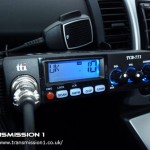
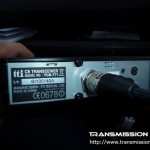
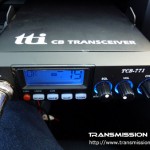

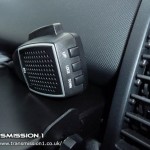
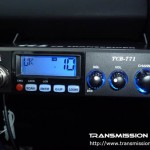
Hello.after I’d installed this cb in my lorry I experienced a problem.the swr meter shows different readings while handling the microphone.and at am mode it makes silent but hearable sound while pressing the ptt button. Is that bad grounding of the cb or faulty mic?thanks.Petr